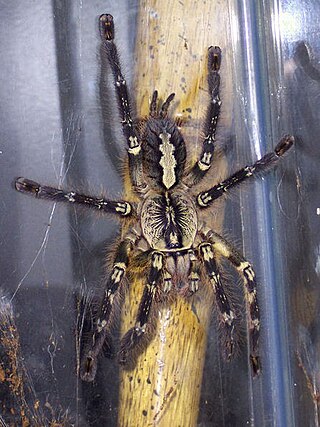
Annandaliella travancorica is a species of tarantula spider found in the Western Ghats of India. It was the first of three members of the genus Annandaliella to be described, therefore the type species.

Annandaliella is a genus of tarantulas that was first described by A. S. Hirst in 1909. As of December 2019 it contains three species endemic to India: A. ernakulamensis, A. pectinifera, and A. travancorica. They are selenogyrid tarantulas, meaning they have a stridulating organ on the inner side of the chelicerae.

Tarantulas comprise a group of large and often hairy spiders of the family Theraphosidae. As of December 2023, 1,100 species have been identified, with 166 genera. The term "tarantula" is usually used to describe members of the family Theraphosidae, although many other members of the same infraorder (Mygalomorphae) are commonly referred to as "tarantulas" or "false tarantulas". Some of the more common species have become popular in the exotic pet trade. Many New World species kept as pets have setae known as urticating hairs that can cause irritation to the skin, and in extreme cases, cause damage to the eyes.

Psalmopoeus irminia, also known as the Venezuelan suntiger, is a species of tarantula endemic to Venezuela, Guyana and Brazil. They were first described in 1994 by F. Saager.

Aphonopelma anax, commonly known as the Texas tan tarantula, is a species of spider belonging to the family Theraphosidae native to southern Texas and northern Mexico.

Poecilotheria ornata, known as the fringed ornamental or ornate tiger spider, is a large arboreal tarantula, which is endemic to Sri Lanka. Their legspan sometimes reaches 10 inches (25 cm) in females, and is probably the second largest of the genus, behind Poecilotheria rufilata.

Neoheterophrictus is a genus of tarantula in the family Theraphosidae. It comprises 8 species, all found in India.
Neoheterophrictus bhori is a species of tarantula. It is native to Parambiculam, Western Ghats, Cochin province, India, in present-day Kerala state.
Euphrictus is a genus of tarantula which is found in Africa. It is part of the subfamily Selenogyrinae.
Annandaliella pectinifera is a species of tarantula, a type of spider, in the subfamily Selenogyrinae. It is endemic to India.
Haploclastus psychedelicus, synonym Thrigmopoeus psychedelicus, is a theraphosid spider. It is native to India.
Selenogyrus caeruleus is a species of tarantula native to Sierra Leone.
Augacephalus is a genus of harpacterine theraphosid spiders. It has three species, all of which are found in Africa.
Haploclastus is a genus of Indian tarantulas that was first described by Eugène Simon in 1892. The genus Phlogiodes has been synonymized with Haploclastus by some authors.
Sahydroaraneus is a genus of spiders in the family Theraphosidae. It is found in India and was first described in 2014 by Mirza & Sanap.
Sandinista lanceolatum is a species of spider in the family Theraphosidae (tarantulas), native to Nicaragua and Costa Rica.

Idiothele mira, also known as the blue-foot baboon is a species of fossorial tarantula endemic to South Africa. It has a striking blue coloration on the dorsal (upper) side of the tarsi and metatarsi on each leg. Furthermore, the species is well known for belonging to one of two described genera of theraphosids that build a trapdoor, the other being Typhochlaena. Its species epithet comes from the Latin for "wonderful", referring to the sky-blue coloration on the tarsi and metatarsi. This species is known from Ndumo and Tembe Elephant Game Reserves, South Africa.

The Selenocosmiinae are a subfamily of tarantulas found throughout South-East Asia and Australia. This subfamily is defined by the presence of a lyra on the maxillae and strikers on the chelicerae, allowing these spiders to stridulate and produce a "hissing" sound. However some species within Phlogiellus may have secondary lost their lyra but retain their strikers. The monophyly of the subfamily has been only tested using genetic data with a handful of genera or species in a few studies. However, these studies found genera that had been previously placed in this subfamily were actual their own separate subfamily (Poecilotheria) and that Selenocosmiinae is most closely related to the Indian Thrigmopoeinae. As of 2021, Selenocosmiinae contains 11 genera.
Phoneutria depilata is a species of spider in the family Ctenidae, found in Central America.

Monocentropus balfouri is a tarantula in the Monocentropus genus. It was first described by Reginald Innes Pocock in 1897. The species is also called Socotra Island blue baboon tarantula, usually shortened to blue baboon tarantula. The scientific name refers to the collector Isaac Bayley Balfour. The Spider is found on Socotra Island, hence the common name. This tarantula is terrestrial and an opportunistic burrower. Like many tarantulas, M. balfouri can be kept as a pet, although it is not a beginner species.










